Continuous Development: Building the thing right, to build the right thing
Test Automation is vital to any organisation wanting to adopt Agile or DevOps, or simply wanting to deliver IT change faster.
Design Complex Systems, Create Visual Models, Collaborate on Requirements, Eradicate Bugs and Deliver Quality!
| Product Overview | Solutions |
| Success Stories | Integrations |
| Book a Demo | Release Notes |
| Free Trial | Brochure |
| Pricing |
Our innovative solutions help you deliver quality software earlier, and at less cost!
![]() AI Accelerated Quality Scalable AI accelerated test creation for improved quality and faster software delivery.
AI Accelerated Quality Scalable AI accelerated test creation for improved quality and faster software delivery.
![]() Test Case Design Generate the smallest set of test cases needed to test complex systems.
Test Case Design Generate the smallest set of test cases needed to test complex systems.
![]() Data Subsetting & Cloning Extract the smallest data sets needed for referential integrity and coverage.
Data Subsetting & Cloning Extract the smallest data sets needed for referential integrity and coverage.
![]() API Test Automation Make complex API testing simple, using a visual approach to generate rigorous API tests.
API Test Automation Make complex API testing simple, using a visual approach to generate rigorous API tests.
![]() Synthetic Data Generation Generate complete and compliant synthetic data on-demand for every scenario.
Synthetic Data Generation Generate complete and compliant synthetic data on-demand for every scenario.
![]() Data Allocation Automatically find and make data for every possible test, testing continuously and in parallel.
Data Allocation Automatically find and make data for every possible test, testing continuously and in parallel.
![]() Requirements Modelling Model complex systems and requirements as complete flowcharts in-sprint.
Requirements Modelling Model complex systems and requirements as complete flowcharts in-sprint.
![]() Data Masking Identify and mask sensitive information across databases and files.
Data Masking Identify and mask sensitive information across databases and files.
![]() Legacy TDM Replacement Move to a modern test data solution with cutting-edge capabilities.
Legacy TDM Replacement Move to a modern test data solution with cutting-edge capabilities.
See how we empower customer success, watch our latest webinars, read our newest eBooks and more.
![]() Events Join the Curiosity team in person or virtually at our upcoming events and conferences.
Events Join the Curiosity team in person or virtually at our upcoming events and conferences.
![]() Blog Discover software quality trends and thought leadership brought to you by the Curiosity team.
Blog Discover software quality trends and thought leadership brought to you by the Curiosity team.
![]() Help & Support Find a solution, request expert support and contact Curiosity.
Help & Support Find a solution, request expert support and contact Curiosity.
![]() Success Stories Learn how our customers found success with Curiosity's Modeller and Enterprise Test Data.
Success Stories Learn how our customers found success with Curiosity's Modeller and Enterprise Test Data.
![]() Documentation Get started with the Curiosity Platform, discover our learning portal and find solutions.
Documentation Get started with the Curiosity Platform, discover our learning portal and find solutions.
![]() Integrations Explore Modeller's wide range of connections and integrations.
Integrations Explore Modeller's wide range of connections and integrations.
Curiosity are your partners for designing and building complex systems in short sprints!
![]() Meet Our Team Meet our team of world leading experts in software quality and test data.
Meet Our Team Meet our team of world leading experts in software quality and test data.
![]() Our History Explore Curiosity's long history of creating market-defining solutions and success.
Our History Explore Curiosity's long history of creating market-defining solutions and success.
![]() Our Mission Discover how we aim to revolutionize the quality and speed of software delivery.
Our Mission Discover how we aim to revolutionize the quality and speed of software delivery.
![]() Our Partners Learn about our partners and how we can help you solve your software delivery challenges.
Our Partners Learn about our partners and how we can help you solve your software delivery challenges.
![]() Careers Join our growing team of industry veterans, experts, innovators and specialists.
Careers Join our growing team of industry veterans, experts, innovators and specialists.
![]() Press Releases Read the latest Curiosity news and company updates.
Press Releases Read the latest Curiosity news and company updates.
![]() Success Stories Learn how our customers found success with Curiosity's Modeller and Enterprise Test Data.
Success Stories Learn how our customers found success with Curiosity's Modeller and Enterprise Test Data.
![]() Blog Discover software quality trends and thought leadership brought to you by the Curiosity team.
Blog Discover software quality trends and thought leadership brought to you by the Curiosity team.
![]() Contact Us Get in touch with a Curiosity expert or leave us a message.
Contact Us Get in touch with a Curiosity expert or leave us a message.
4 min read
 Thomas Pryce
10 July 2019 11:36:12 BST
Thomas Pryce
10 July 2019 11:36:12 BST

Welcome to part 2/5 of 5 Reasons to Model During QA!
Part one of this series discussed how formal modelling enables “shift left” QA. It discussed how modelling helps eradicate the majority of defects that emerge during the design phase, working to avoid costly and time-consuming rework. Flowchart modelling was also seen to be possible during short iterations, introducing all the benefits of formal modelling to Agile or hybrid environments.
Modelling the requirements therefore increases the likelihood that code will reflect the business needs first time round. Flowchart modelling also enables more rigorous testing further “right” in the delivery lifecycle, after the code has been written.
Model-Based Testing thereby avoids the bottlenecks created by manual case design, test data allocating and automated test scripting. This can drastically improve testing speed, all while optimising the generated test assets for greater test coverage.
Curiosity Software Ireland and Lemontree Present: “Five Reasons to Model During QA”
The mathematical precision of the flowchart models means that test cases can be generated directly from them. Flowcharts are directed graphs that map logical journeys from start points to end points in the model. Each path is equivalent to a test case that can be identified using automated graphical analysis. This mathematical analysis works like a GPS, identifying possible routes through a city map: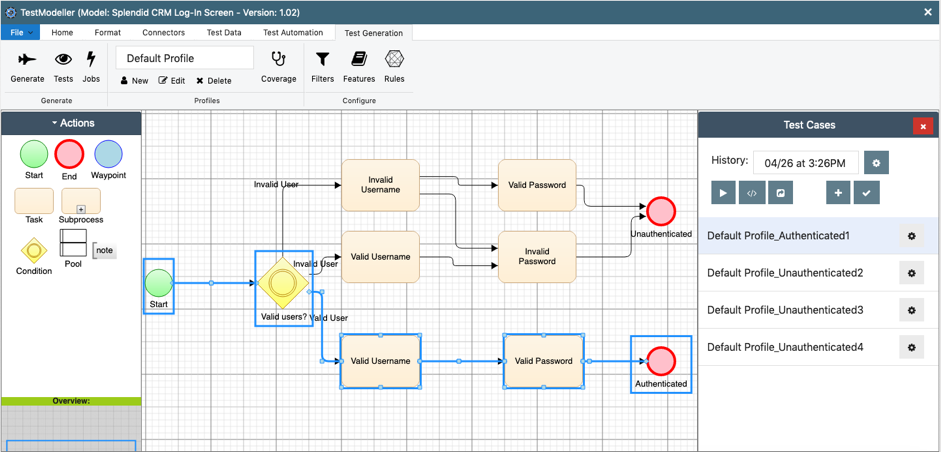
Automated test case design in Test Modeller automatically identifies test cases from
easy-to-use models.
Automated test generation significantly increases testing speed, removing the need to identify and create copious test cases. Even a simple system today contains thousands or even millions of paths through its logic, each of which could be a test. These tests must be repetitious in order to test a system fully, containing numerous overlapping test steps like clicking a certain button or filling in a given field. Manually creating tests for each distinct combination of user activity and data is simply too slow and labour-intensive for short iterations.
Models by contrast consolidate overlapping test steps, each of which only needs defining once as a node in the model. The blocks are then connected up, before applying algorithms to create every test case contained in the model automatically.
What’s more, Test Modeller provides connectors to synchronise the generated test suites with technologies across DevOps pipelines. Test cases and steps can be auto-populated in Application Management, Project Management, and CI/CD tools. This not only avoids the time spent creating repetitious test cases, it also removes the frustration of having to upload each test one-by-one to management tools.
Using Test Modeller, test data can be found or created automatically as test cases are generated from the model. This avoids bottlenecks created by manual test data provisioning, providing on demand and parallel access to test data for every test.
Efficient and rigorous testing depends on constant access to data with which to execute every test. However, test teams are still frequently provisioned with a limited number of large copies of production data, creating test data bottlenecks and undermining testing quality.
QA teams in this scenarios are forced to search through the vast production data for the exact data combinations they need. What’s worse, the production data contains only a fraction of the data needed for sufficient test coverage, lacking edge cases and the combinations needed to test new functionality.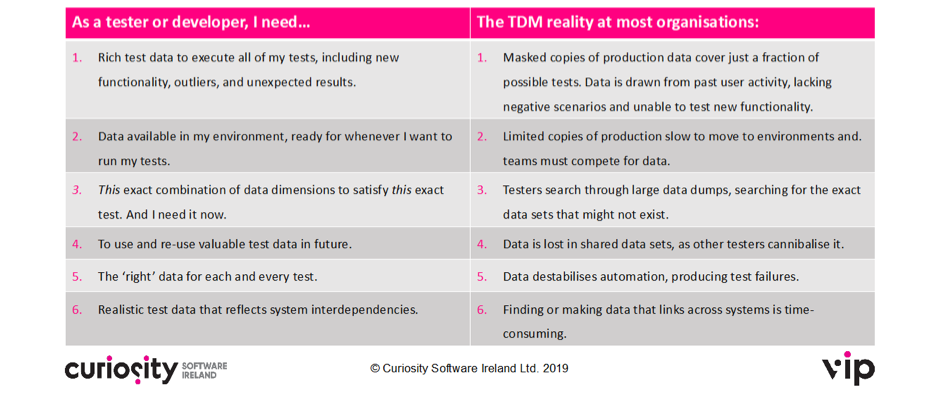
Test Data Management: The ideal versus the reality.
Test teams are therefore frequently forced to create complex data by hand, wasting time and leading to test failures from inaccurate data. Further delays mount when useful data is lost after a data refresh, or is edited by another tester working with the same database.
Model-Based Testing can eradicate these test data bottlenecks, automatically finding or making test data for each test as it is created.
In Test Modeller, test data values and variables are assigned to each block in the flowchart model. This specifies the data needed to traverse each logical journey through the model: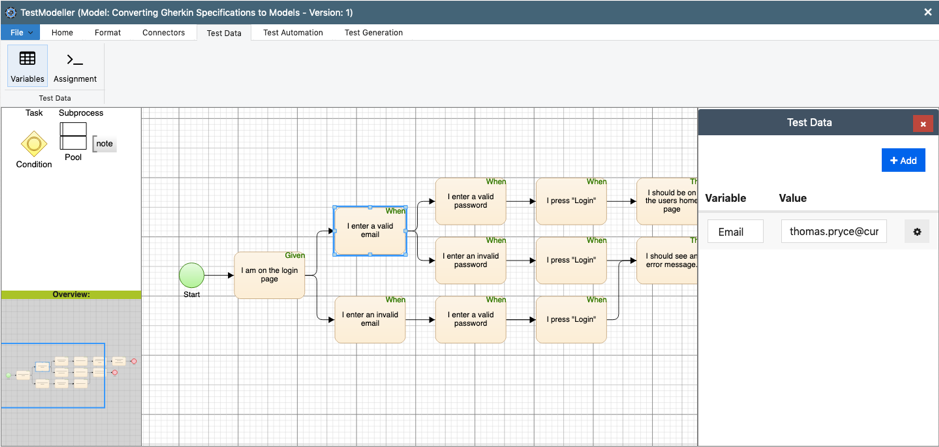
Complete test data is assigned at the model level in Test Modeller.
Test Modeller then compiles the test data as test cases are automatically created, linking it to each test generated from the model. This lifts test data constraints, providing parallel teams with instant access to the data they need to execute tests.
The data defined at the model level can be either static or dynamic. Dynamic data definition creates synthetic test data as tests are generated, producing a diverse range of production-like values. Over 500 synthetic data generation functions can be combined and resolve “just in time” during automated test generation: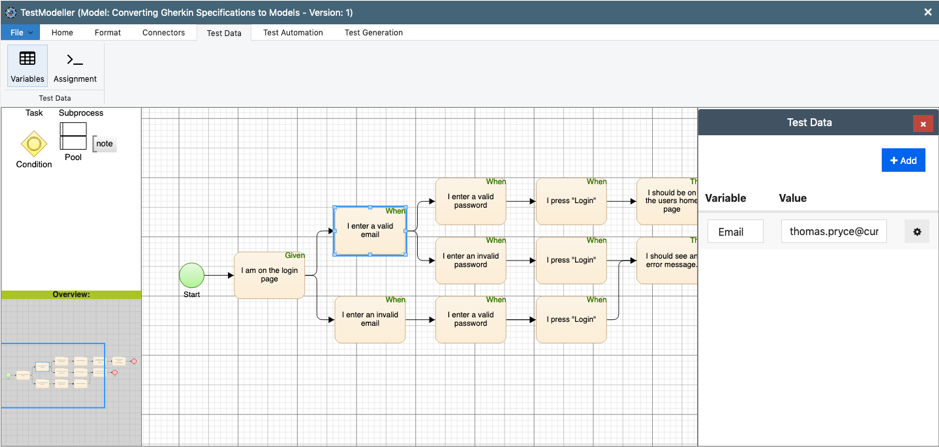
Complete test data is assigned at the model level in Test Modeller.
The dynamic data functions resolve one-by-one as each test is created, meaning that the test cases are linked to distinct and varied data. The data can furthermore include all the data needed for negative scenarios and outliers needed for rigorous testers, each of which can be defined easily and rapidly.
Model-Based Testing, lastly, enables the generation of automated test code. This code will execute the test cases and data generated from the same model, eliminating another significant QA bottleneck.
Test execution automation is necessary to run the number of functional regression tests required by modern applications, while testing types like Performance testing require automation.
However, automation frameworks often require slow and manual test scripting or otherwise on keyword configuration. Such manual test creation is simply not fast enough when thousands of new tests are introduced with each code commit, and automation engineers are constantly playing catch-up when they create automated tests by hand.
Test Modeller by contrasts generates automated test code automatically as test cases are created from its models. Like test data values, automation logic is assigned to the flowchart models. This uses a simple-to-use, visual automation builder, creating tests with drop-down boxes and fill-in-the-blank fields: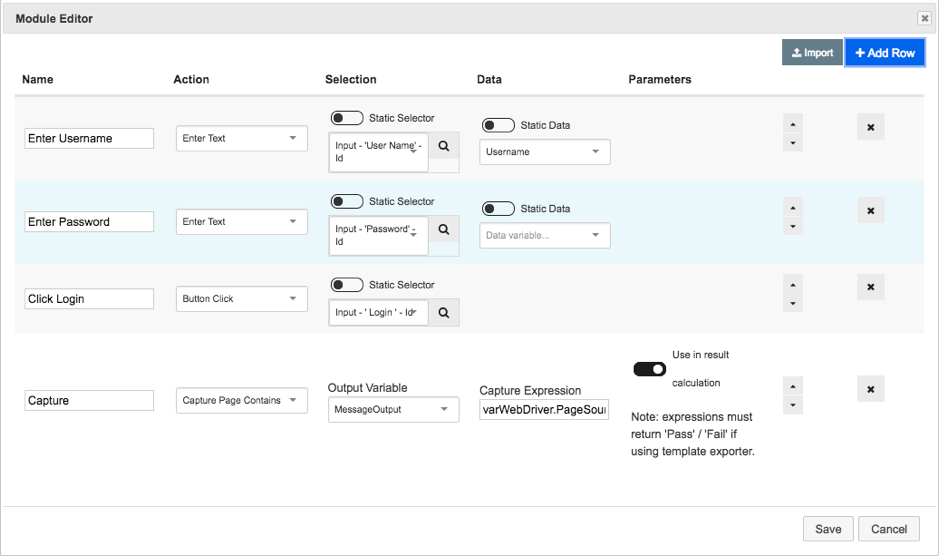
A simple, “low code” approach to building automated tests.
Testers without coding backgrounds can use this approach to automate tests. They might use the standard automation recipes that are provided out-of-the-box by Test Modeller. Alternatively, Test Modeller can parse code created in manual, open source or homegrown frameworks. This makes the objects and actions re-usable in the “low code” automated test builder.
This approach combines the flexibility of coded frameworks with the simplicity of low code test automation. A small core of automation engineers can focus on feeding the new custom code needed to test complex systems, rather than on scripting repetitious tests. Broader QA teams can then re-use the code to auto-generate tests from easy-to-maintain flowcharts.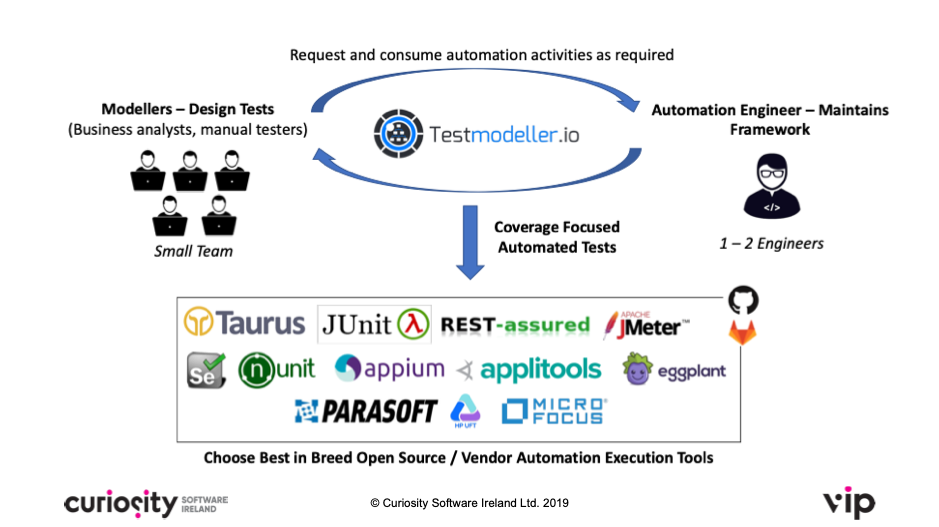
The flexibility of coded frameworks, the simplicity of “low code”. Anyone can automate their
tests with Test Modeller.
Modelling enables QA teams to rapidly move from requirements to automated test suites and data. The models can furthermore be built rapidly in-sprint to avoid the bottlenecks of test asset creation. This is not only a significant time saver, but the systematic generation can significantly improve test coverage. This quality gain of Model-Based Testing is the focus of the next article in this series.

Test Automation is vital to any organisation wanting to adopt Agile or DevOps, or simply wanting to deliver IT change faster.

In the world of software development, generative AI has established itself as a formidable ally, assisting developers in coding and detecting...

Software delivery teams across the industry have embraced agile delivery methods in order to promote collaboration between teams and deliver new...

Welcome to part 3/5 of 5 Reasons to Model During QA! Part one of this series discussed how modelling enables “shift left” QA, eradicating potentially...

Model-Based Testing (MBT) itself is not new, but Model-Based Test Automation is experiencing a resurgence in adoption. Model-Based Testing is the...

Welcome to the final instalment of 5 Reasons to Model During QA! If you have missed any of the previous four articles, jump back in to find out how...

In the dynamic, interconnected world of software development, clarity is key. Yet, requirements engineering - the process of defining, documenting,...

Welcome to part 4/5 of 5 Reasons to Model During QA! If you have missed any previous instalments, use the following links to see how modelling can:

We rarely post ‘product’ articles here at Curiosity, preferring instead to draw on our team’s thought and expertise. This article is no different,...